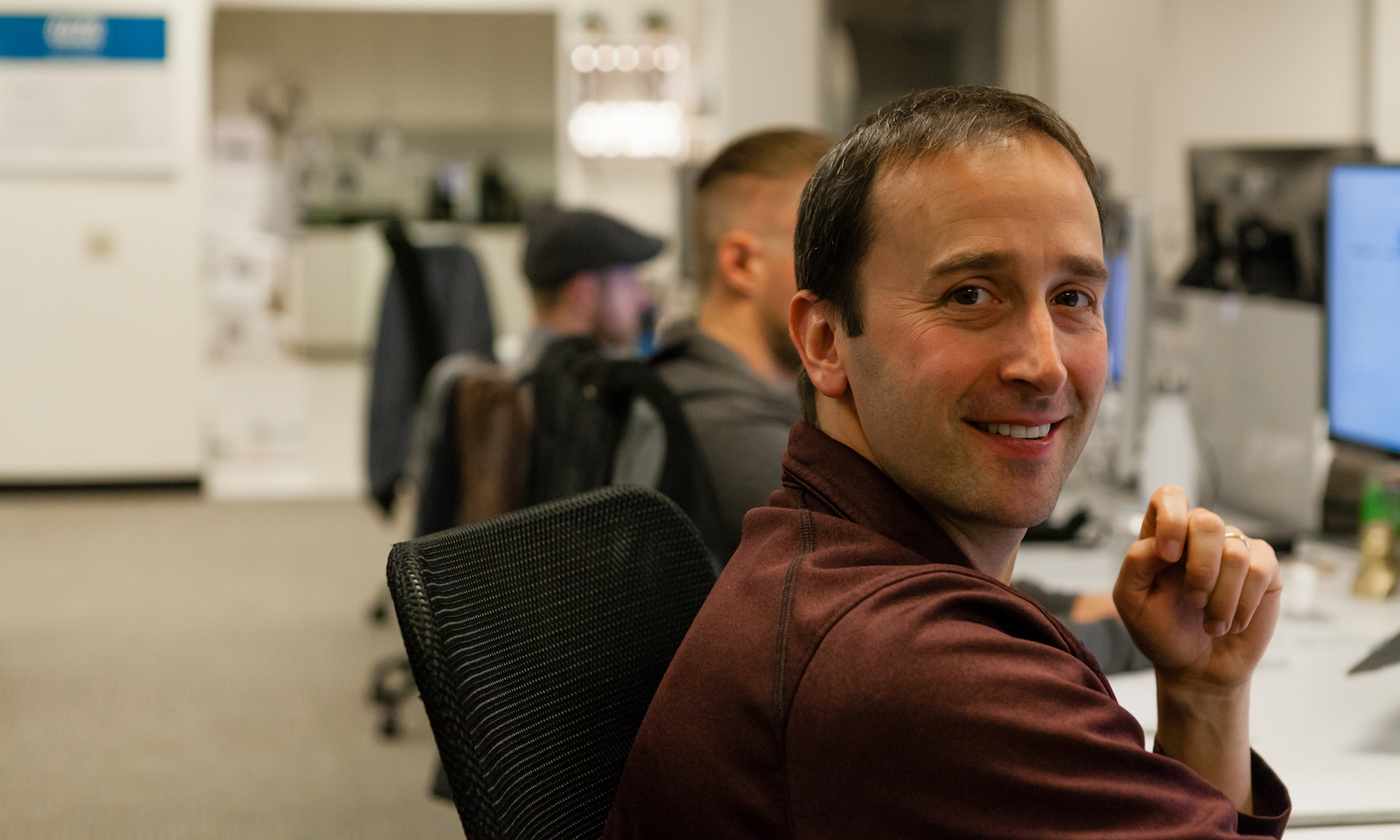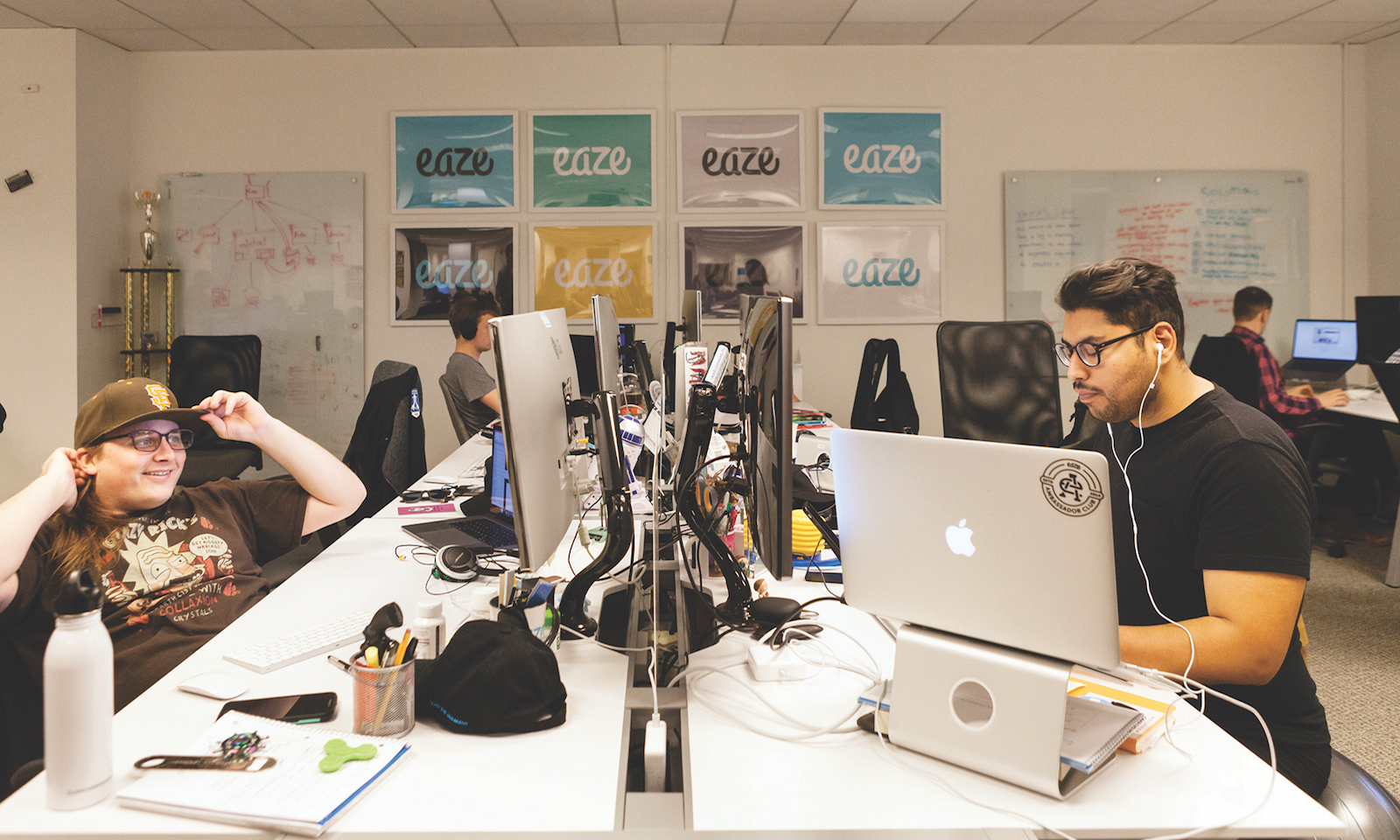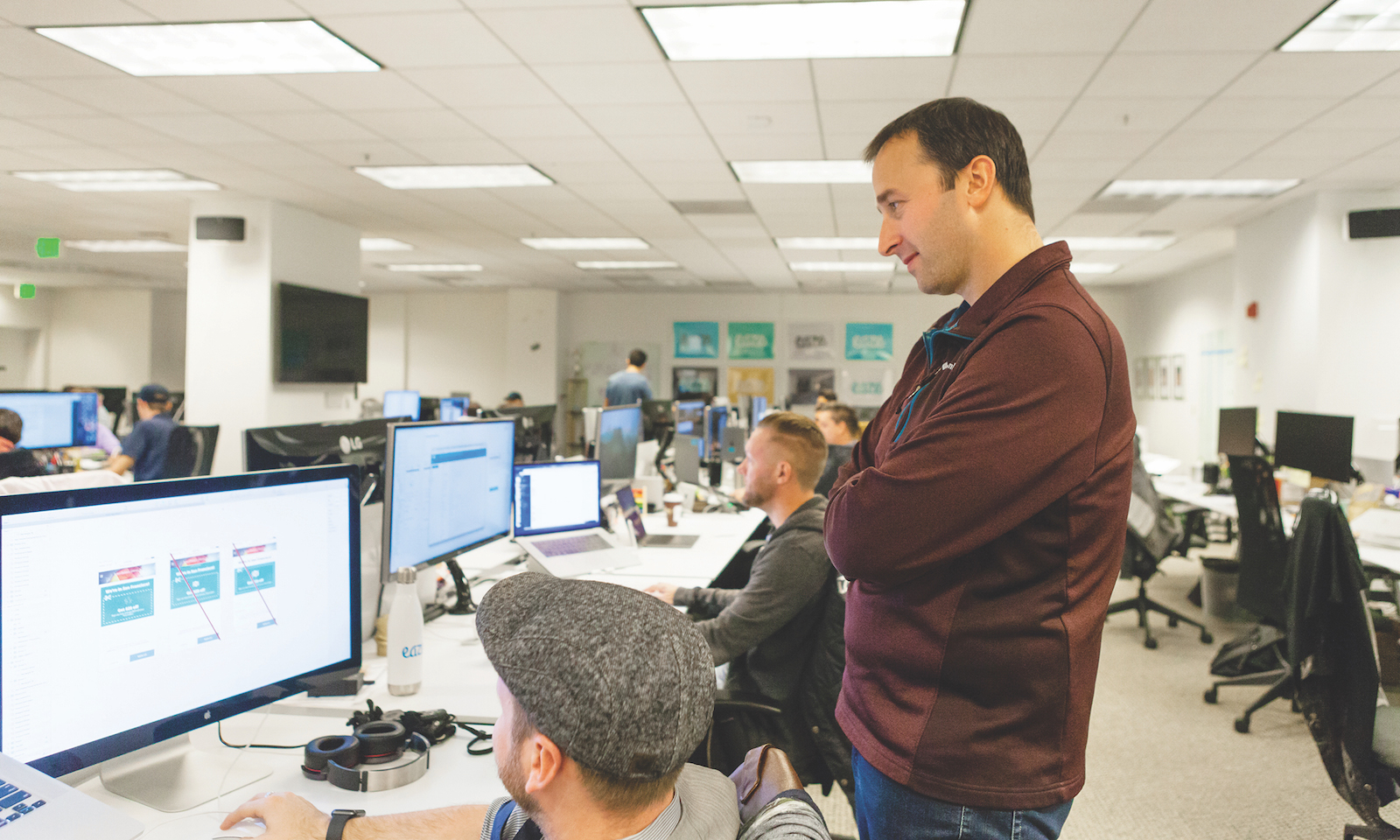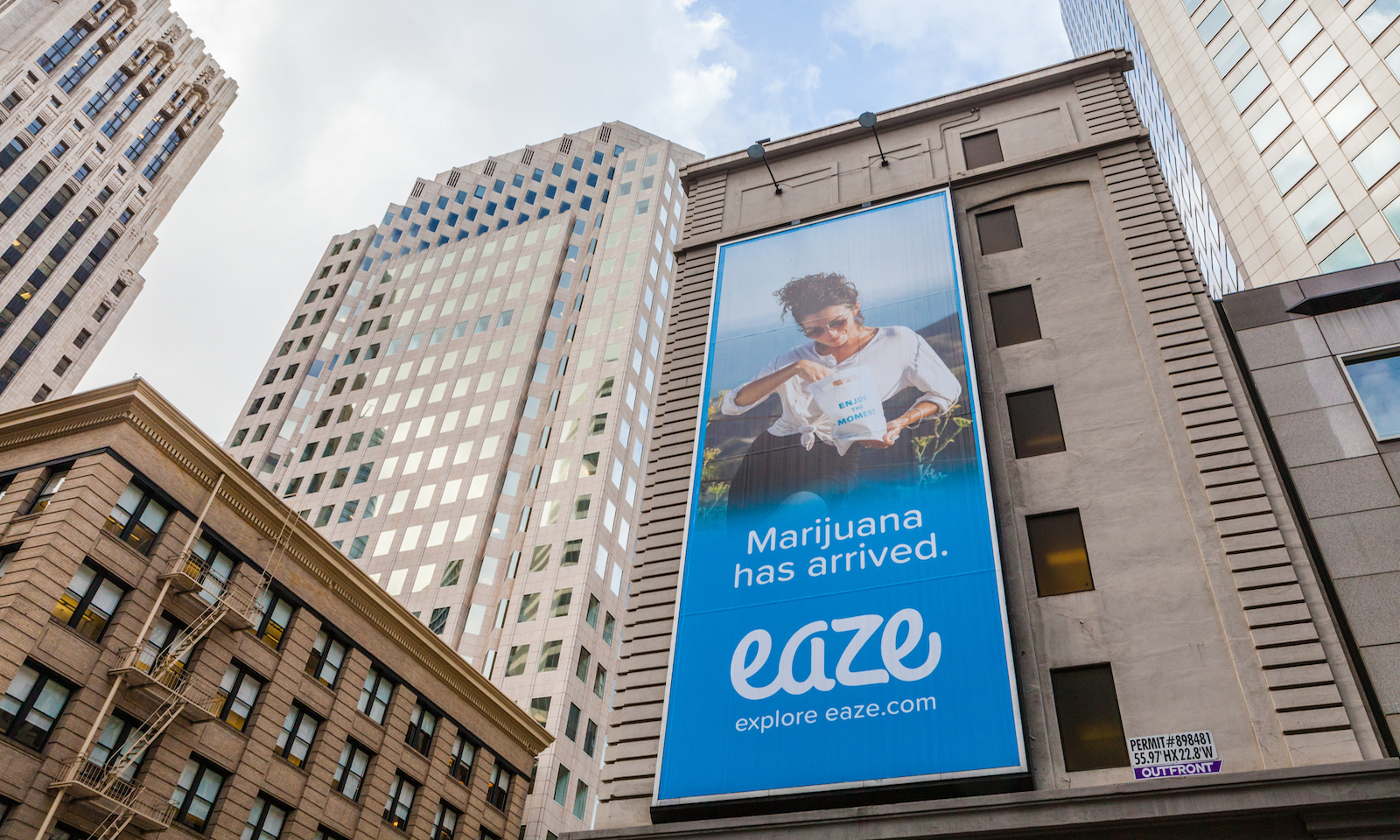Eaze: The Billion-Dollar Maybe
Eaze says it can sell $1 billion worth of marijuana by 2020 — and become profitable. Which will be the bigger lift?
Contrary to whatever you may have heard, Eaze, the San Francisco-based marijuana delivery platform, is not the “Uber of marijuana.” Not in any official way.
“We never said that,” corrects Jim Patterson, the company’s CEO. “The press said that.”
The day after Halloween, Patterson is sitting in a conference room at Eaze’s offices in a downtown San Francisco high-rise. Explaining how the new era of legal adult-use marijuana in California will affect his company (which is the cannabis industry’s best-funded startup with $52 million in venture capital raised to date), he shifts between an assertive confidence that stops just shy of a smirk and a low-key but simmering intensity.
You look at Patterson and you see a guy who works late, who’s under some pressure, who spent four years in the Air Force in the early 2000s. What you also see — even if the clean-cut, plucked-straight-out-of-central-casting for “generic Silicon Valley guy, late-30s” doesn’t look it — is that he’s also the guy who is telling the group of titanic investors writing him $27 million in checks during his latest funding round that, in three years’ time, he can sell a billion dollar’s worth of weed in just a year.

Eaze CEO Jim Patterson works in the company’s San Francisco headquarters.
On the other side of a glass wall, young men sporting man buns and women in high-waisted jeans are milling about, sitting in front of huge rectangular Apple monitors, or sprawled with laptops on couches, eyes glued to the work that will earn them six figures a year. They’re the ones responsible for keeping Eaze’s promise, and making sure that when someone, somewhere else in the city, picks up their smartphone, pecks at the screen, pauses to ponder, scrolls, and pecks again, that marijuana is on the way.
If Patterson and his team are doing their jobs, about 20 to 25 minutes later, a car will pull up outside that someone’s home, their office, or wherever they are. The driver will hand them a package containing a vape cartridge, or a few grams of bud, or a carefully and slickly designed pack of pre-rolls — whatever product on Eaze’s menu that sparked their fancy. Then, if all goes well, that process will repeat itself, thousands and thousands of times over. California’s delivery laws are in flux as the state works to create permanent regulations after releasing temporary regulations in November, but the goal remains the same: fast, reliable and accessible cannabis on a massive scale.
When I met with Patterson, he was about a month away from his first anniversary as chief executive. (Eaze’s founder, Keith McCarty, Patterson’s old co-worker at Yammer — a startup acquired by Microsoft for more than $1 billion, was removed as CEO just a month after legalization, the biggest moment in his young company’s history.) Nearly every news item concerning Eaze since its summer 2014 launch has trotted out the “Uber of” comparison — already an exhausted Silicon Valley trope — as a tagline in one way or another.
In this instance, it would be hard to blame the media for pushing fake news: The similarities between the two companies are manifest.
Both promise their users on-demand fulfillment in a matter of minutes at the swipe of a smartphone. Both are darlings of Silicon Valley venture capitalists. At $52 million raised to date, Eaze may be the most-funded young firm working in the cannabis sector. (“May be,” only because if there is a company with more interest from investors on Sand Hill Road, they’ve managed the unlikely feat of drawing that interest and the attendant cash while eluding publicity). The $52 million investment is a pittance compared to the fortunes sunk into non-cannabis-related companies that nobody’s heard of, but raising that sum was a mammoth task for a cannabis company.

“You have no idea how hard it is to raise money in this space,” Patterson says.
And to do that, Eaze had to look far and wide: One of its main investors, DCM Ventures, whose main partner, David Chao, is now on Eaze’s board of directors, is partially based in China — beyond the reach of the U.S. Justice Department.
Both Uber and Eaze are heavily subsidized by their investors. Uber offers rides well below cost, a practice that’s squeezing competition and drawing users, but at the cost of incinerating a huge amount of investor cash.
And Eaze has for years offered new users free or heavily discounted cannabis in exchange for signing up. You could say the practice is having an Uber effect, but Eaze is doing one better: Existing delivery services without a comparable runway are finding it difficult (if not impossible) to compete. This is one way Patterson can try to ensure Eaze meets its earnings goals, in a very Uber way: Laying waste to the field, eliminating every hint of a threat.
Both apps also feature a buffer zone between themselves and the product they offer, allowing for lower overhead and less legal exposure.
Uber is a ride-hail service that doesn’t own the fleet of vehicles ferrying people around cities across the world, and Eaze offers cannabis delivery within 20 minutes, without ever touching a gram of marijuana.
All the cannabis is handled by the company’s partners, cannabis dispensaries who handle the product and dispatch the drivers, in exchange for giving Eaze a flat fee, the price of which varies from vendor to vendor.
Some of Uber’s more troubling traits also apply to Eaze. Both companies are also defendants in employment lawsuits filed by drivers who claim full-time employee status; the same Boston-area workplace lawyer is handling both cases.

But forget Uber. Patterson is staking out an even bolder claim. “We’re something between Uber,” he says, “and Amazon.” The world’s biggest startup, and the world’s biggest online retailer — the company that snapped up Whole Foods and whose owner picked up The Washington Post like the rest of us pick up the Sunday paper and a burrito. Find the mean and that’s Eaze.
Heady stuff, but this is the marijuana startup, in what should be the biggest marijuana marketplace in the world, and Patterson is making these assertions in the few gray hours left before the dawn of recreational marijuana sales. To pledge anything less than an Amazon-like total world domination — and sooner rather than later — would be inappropriate. Boring.
Patterson is right to have his mind on the job. Eaze wants to see $1 billion worth of marijuana sold through its platform by 2020, according to a promise in the pitch deck sent to potential investors during the company’s most-recent funding round. Leaked and first reported publicly in September in Marketwatch, Eaze is planning on stupendous year-over-year growth — a fabled Silicon Valley hockey stick-spike from $60 million a year in 2017 to $500 million in 2019, and then doubling again from there.
That would also mean a remarkable turnaround for the company’s finances. In its three years in existence, Eaze has burned through more than half of the $52 million it’s raised, at a rate as high as $1 million a month, as Marketwatch reported.
Instead of drowning, by 2020, Eaze plans to reverse this tide entirely and become profitable — a trick that even Uber has yet to pull off. Ambitious? You bet. Audacious? Maybe not.
“I can understand why people in the cannabis industry are like, ‘Ah, Eaze is burning all this money! What are they doing with it?’ Well, we’re building technology,” Patterson says. “We’re a tech company. Maybe people who aren’t in this industry don’t understand the cost structure of a tech company.”
“I have an engineering team of 25 people who make an average of $180,000 a year. That’s very expensive,” he says, rattling off figures and facts like he’s reading bullet points. “The reason why tech companies can be very, very valuable is scale. Adding a thousand new users will cost us nothing. Eaze.com can be scaled to infinity — just like Amazon.com.”
So far, forces outside Eaze’s control are breaking the right way. California voters did their job and legalized recreational marijuana. In an instant, Eaze’s potential user base expanded from the roughly 1 million Californians with a medical-marijuana recommendation to the tens of millions of residents and visitors to the state who are 21 and over. When California merely had legal medical marijuana, about 200,000 people signed up to use the platform at one time or another, according to the company, and some of those 200,000 also acquired their physician’s recommendation via the company’s dirt-cheap “EazeMD” telemedicine service. In recreational California, marijuana sales are expected to increase from $2 billion a year to more than $5 billion, according to an official state estimate prepared by the University of California Agricultural Issues Center.

But Eaze needs more outside help than that. The company hopes for another overnight boost with expansion into heretofore-forbidden territory in Los Angeles, once a longstanding ban on delivery will be lifted pending passage of citywide pot regulations. After that, it’s onto Colorado and Washington, the country’s oldest and most established adult-use markets, where more than $2 billion worth of cannabis was sold last year. In those two markets, state law still prohibits delivery. Pushes in 2017 to legalize the practice failed in both states, but, still the thinking goes: Delivery (and with it, Eaze) surely can’t be banned forever.
And most unlike Uber, Eaze is hoping for a boost from government regulation. California is rife with gray-market marijuana: unlicensed delivery services, cannabis not tested by a lab, dispensaries dodging sales taxes. Regulators and cannabis entrepreneurs procuring licenses hope all that off-book activity will be captured by the regulated market, which would benefit Eaze. (And yes, someday, California will probably allow drones to deliver pot. Eaze insists it had no plans to do such a thing, but was happy to take reporters’ calls when the state preemptively banned drone delivery. “Somehow, we got mentioned in Forbes,” Patterson says in gleeful disbelief.)
In this context, staking out a claim to ten figures’ worth of weed isn’t quite so outrageous. It’s a calculated gamble on more legalization, and on more people willing to try cannabis.
“The current legal market is $6 billion a year,” Patterson says. “The bet is that’s going to 10x over the next five to six years. In many ways, Eaze is an option bet on the continued legalization and de-stigmatization of cannabis on a state-by-state basis, roughly at the same trajectory that it’s been going.”
Eaze is also doing what it can to tilt the odds its favor. Largely apolitical up until recently — a $100 contribution from Patterson was the company’s only involvement in Prop. 64, according to campaign finance records — Eaze has hired lobbyists to work the halls in the state capitol in Sacramento. During the first three quarters of 2017, Eaze spent over $90,000 on a lobbying company’s services, which was more than heavy hitters like Cisco Systems and JP Morgan Chase spent on the same lobbying company.
The real deciders, however, are the general public. These are the people who have never tried cannabis: Patterson’s neighbors in Pacific Heights, far away from the company’s bright-blue billboards proclaiming to audience’s captive on freeways that “Marijuana has arrived.” Eaze plans on lobbying these elite city-dwellers in a massive pro-marijuana marketing campaign, the goal of which is nothing short of making as many states as possible adopt a San Francisco attitude on cannabis.
“Our mission [in 2018] is to make marijuana mainstream,” Patterson says, matter of fact. How does he plan to do that? Super Bowl ads? Celebrity marketing campaigns? Patterson demurs, keeping that card close to the vest. He may not quite yet know himself. It’s a fast-changing world — and, to be fair, there are marijuana executives all over the state, with decades of experience or just a few minutes’ worth, all asking themselves the same question and second-guessing the answers.
“In many ways, we view this as the beginning,” he says. “Everything up to this point was just a warmup.”
Originally published in Issue 29 of Cannabis Now. LEARN MORE
TELL US, have you tried getting marijuana delivered to you?



























